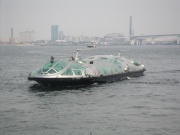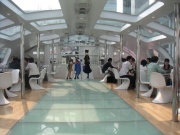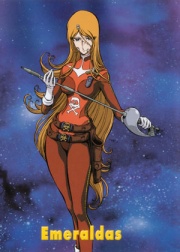Leiji Matsumoto
From Animepedia
| Revision as of 20:05, 11 November 2006 (edit) Princess Minako (Talk | contribs) ← Previous diff |
Revision as of 18:50, 27 November 2006 (edit) Regex (Talk | contribs) (Added category) Next diff → |
||
| Line 15: | Line 15: | ||
| Leiji Matsumoto has also designed and commissioned the building of a water bus in Tokyo. The water bus runs between Asakusa and Toyosu, and is called Himiko. Its done in true Leiji style with its futuristic look, interior décor, and complete with standups of Maetel, the conductor from Galaxy Express 999, and Tetsuro. There is also about two dozen four feet tall bronze statues in the downtown area in Tsuruga all put up in 1999. They depict characters and scenes from both Space Battleship Yamato and Galaxy Express 999 with a plaque at the base of each explaining who the character is and signed by Leiji Himself. | Leiji Matsumoto has also designed and commissioned the building of a water bus in Tokyo. The water bus runs between Asakusa and Toyosu, and is called Himiko. Its done in true Leiji style with its futuristic look, interior décor, and complete with standups of Maetel, the conductor from Galaxy Express 999, and Tetsuro. There is also about two dozen four feet tall bronze statues in the downtown area in Tsuruga all put up in 1999. They depict characters and scenes from both Space Battleship Yamato and Galaxy Express 999 with a plaque at the base of each explaining who the character is and signed by Leiji Himself. | ||
| + | [[Category:Manga Artists]] | ||
Revision as of 18:50, 27 November 2006
Leiji Matsumoto has been nicknamed the Grandfather of anime. He is responsible for such classics as Space Battleship Yamato and Galaxy Express 999. He was born January 25th, 1938 in Kurume on the island of Kyushu, Japan, under the name Akira Matsumoto. He didn’t change his name to Reiji (or Leiji for western dialects) until 1965. His father was an officer in the Imperial Air Force. Leiji started drawing when he was 8 and was inspired by Osamu Tezuka.He made his debut in 1953 under his real name, Akira. He entered a contest by Manga Shonen with a manga called Mitsubachi no Boken (The Adventures of a Bee). The magazine ended up publishing several of his mangas under his real name.
Most of his early works were shojo manga, incidentally it turns out he hates the genre. In 1957 he fulfills one of his dreams and moves to the Benkyo area of Tokyo, where he lives for 6 years.. By the mid 1960’s he was finally able to write Shonen manga.
It was in 1968 that he published his first sci-fi manga, Sexaroid. The rest of Leiji’s works will fall under three main genre; Sci fi (Space Battleship Yamato, Galaxy Express 999, Harlock Saga, and Emeraldas being some of the most famous), War (The Cockpit), and Western (Gun Frontier). The start to his acclaim began in 1973 when he leleased Otoko Oidon ( I am a man). In 1974 he was involved in Space Battleship Yamato. Leiji was not the original creator of the story, that was a Yoshinobu Nishizaki, he was the artistic director and graphics designer for the series. Although it can be argued that the artistic part was what made Yamato so popular. Leiji went on to release both Captain Harlock and Galaxy Express 999 in 1977. These branched out to a sequal Adieu Galaxy Express 999, and many other series that were spin offs such as Maetel Legend, Queen Emeraldas, and Queen Millennia. These related stories all take place in the same universe, dubbed the Leijiverse. By the 1980’s Leiji seemed to have disappeared from the anime scene, but not after leaving a legacy.
He had tried to create a new series based on the Yamato called Great Yamato, but it had to be renamed Great Galaxy due to legal issues with the original creator of the series Nishizaki. The legal battle ended with the agreement that Leiji Matsumoto could not use the name, plot or characters, and Nishizaki cannot use any of the artwork. Yet it was during this time that he was introduced to Kazuko Kawashima, who sang the Harlock theme and later went on to fame in Saint Seiya.

Leiji came back with a bang in the 1990’s with a new Galaxy Express 999 series, and the supervising of The Cockpit into an OVA. He even went on to make a very memorable “Rock-Anime” Interstella 5555, which was a collaboration with the French House band Daft Punk. The music videos for the popular songs “One More Time” and “Too Long” were actually short snips from the full length anime movie, once again bringing Leiji back into the main stream and lime light. He still is working and drawing on several new and ongoing projects, including such new creations as Kagero no monsho, Case Hard, a new Harlock-OVA, and a continuation of Galaxy Express 999 (which he publishes each month in a magazine.
He is also very enthralled with German culture, as seen in his works. Harlocks family is german, and he uses Germanic names, such as Maja, the tragic love of Harlock that dies and whose blood is used by Emeraldas to paint her pirate flag red. Even one of Harlock’s movies is a remake of a German Composer, Wagner’s, symphony. When Leiji released the movie he kept the German name to it as well.
Leiji Matsumoto has also designed and commissioned the building of a water bus in Tokyo. The water bus runs between Asakusa and Toyosu, and is called Himiko. Its done in true Leiji style with its futuristic look, interior décor, and complete with standups of Maetel, the conductor from Galaxy Express 999, and Tetsuro. There is also about two dozen four feet tall bronze statues in the downtown area in Tsuruga all put up in 1999. They depict characters and scenes from both Space Battleship Yamato and Galaxy Express 999 with a plaque at the base of each explaining who the character is and signed by Leiji Himself.

